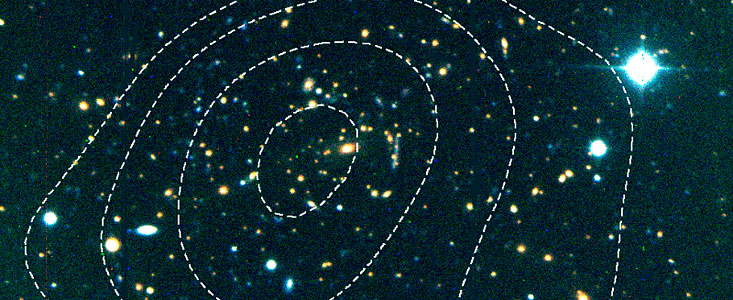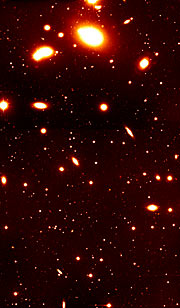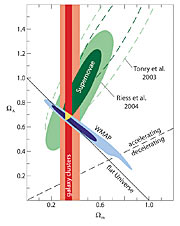Tisková zpráva
Charting the Giants
Largest Census Of X-Ray Galaxy Clusters Provides New Constraints on Dark Matter.
3. června 2004
Astronomers unveil a few hundred clusters of galaxies by observing their emission in the X-Ray wavelengths. This study also provides new insights on the amount of dark matter in the Universe.
Clusters of galaxies
Clusters of galaxies are very large building blocks of the Universe. These gigantic structures contain hundreds to thousands of galaxies and, less visible but equally interesting, an additional amount of "dark matter" whose origin still defies the astronomers, with a total mass of thousands of millions of millions times the mass of our Sun. The comparatively nearby Coma cluster, for example, contains thousands of galaxies and measures more than 20 million light-years across. Another well-known example is the Virgo cluster at a distance of about 50 million light-years, and still stretching over an angle of more than 10 degrees in the sky!
Clusters of galaxies form in the densest regions of the Universe. As such, they perfectly trace the backbone of the large-scale structures in the Universe, in the same way that lighthouses trace a coastline. Studies of clusters of galaxies therefore tell us about the structure of the enormous space in which we live.
The REFLEX survey
Following this idea, a European team of astronomers [2], under the leadership of Hans Böhringer (MPE, Garching, Germany), Luigi Guzzo (INAF, Milano, Italy), Chris A. Collins (JMU, Liverpool), and Peter Schuecker (MPE, Garching) has embarked on a decade-long study of these gargantuan structures, trying to locate the most massive of clusters of galaxies.
Since about one-fifth of the optically invisible mass of a cluster is in the form of a diffuse very hot gas with a temperature of the order of several tens of millions of degrees, clusters of galaxies produce powerful X-ray emission. They are therefore best discovered by means of X-ray satellites.
For this fundamental study, the astronomers thus started by selecting candidate objects using data from the X-ray Sky Atlas compiled by the German ROSAT satellite survey mission. This was the beginning only - then followed a lot of tedious work: making the final identification of these objects in visible light and measuring the distance (i.e., redshift [3]) of the cluster candidates.
The determination of the redshift was done by means of observations with several telescopes at the ESO La Silla Observatory in Chile, from 1992 to 1999. The brighter objects were observed with the ESO 1.5-m and the ESO/MPG 2.2-m telescopes, while for the more distant and fainter objects, the ESO 3.6-m telescope was used.
Carried out at these telescopes, the 12 year-long programme is known to astronomers as the REFLEX (ROSAT-ESO Flux Limited X-ray) Cluster Survey. It has now been concluded with the publication of a unique catalogue with the characteristics of the 447 brightest X-ray clusters of galaxies in the southern sky. Among these, more than half the clusters were discovered during this survey.
Constraining the dark matter content
Galaxy clusters are far from being evenly distributed in the Universe. Instead, they tend to conglomerate into even larger structures, "super-clusters". Thus, from stars which gather in galaxies, galaxies which congregate in clusters and clusters tying together in super-clusters, the Universe shows structuring on all scales, from the smallest to the largest ones. This is a relict of the very early (formation) epoch of the Universe, the so-called "inflationary" period. At that time, only a minuscule fraction of one second after the Big Bang, the tiny density fluctuations were amplified and over the eons, they gave birth to the much larger structures.
Because of the link between the first fluctuations and the giant structures now observed, the unique REFLEX catalogue - the largest of its kind - allows astronomers to put considerable constraints on the content of the Universe, and in particular on the amount of dark matter that is believed to pervade it. Rather interestingly, these constraints are totally independent from all other methods so far used to assert the existence of dark matter, such as the study of very distant supernovae (see e.g. eso9861) or the analysis of the Cosmic Microwave background (e.g. the WMAP satellite). In fact, the new REFLEX study is very complementary to the above-mentioned methods.
The REFLEX team concludes that the mean density of the Universe is in the range 0.27 to 0.43 times the "critical density", providing the strongest constraint on this value up to now. When combined with the latest supernovae study, the REFLEX result implies that, whatever the nature of the dark energy is, it closely mimics a Universe with Einstein's cosmological constant.
A giant puzzle
The REFLEX catalogue will also serve many other useful purposes. With it, astronomers will be able to better understand the detailed processes that contribute to the heating of the gas in these clusters. It will also be possible to study the effect of the environment of the cluster on each individual galaxy. Moreover, the catalogue is a good starting point to look for giant gravitational lenses, in which a cluster acts as a giant magnifying lens, effectively allowing observations of the faintest and remotest objects that would otherwise escape detection with present-day telescopes.
But, as Hans Böhringer says: "Perhaps the most important advantage of this catalogue is that the properties of each single cluster can be compared to the entire sample. This is the main goal of surveys: assembling the pieces of a gigantic puzzle to build the grander view, where every single piece then gains a new, more comprehensive meaning."
Poznámky
[1] This is a coordinated press release with the Max-Planck-Society (Germany; German-language press release) and INAF (Italy; Italian-language press release).
[2] The team is composed of Hans Böhringer, Peter Schuecker, and Wolfgang Voges (Max-Planck Institut für extraterrestrische Physik, Garching, Germany), Luigi Guzzo and Sabrina De Grandi (Osservatorio Astronomico di Brera, Italy), Chris A. Collins (John Moores University, Liverpool, UK), Ray G. Cruddace (Naval Research Laboratory, USA), Amelia Oriz-Gil (Universidad de Valencia, Spain), Guido Chincarini (Osservatorio Astronomico di Brera and Universita di Milano, Italy), Alastair C. Edge (University of Durham, UK), Harvey T. MacGillivray (University of Edinburgh, UK), Doris M. Neumann (CEA Saclay, France), Sabine Schindler (University of Innsbruck, Austria), and Peter Shaver (ESO).
[3] In astronomy, the "redshift" denotes the fraction by which the lines in the spectrum of an object are shifted towards longer wavelengths. Since the redshift of a cosmological object increases with distance, the observed redshift of a remote galaxy also provides an estimate of its distance.
Další informace
The results presented in this Press Release will appear in the research journal Astronomy and Astrophysics ("The ROSAT-ESO Flux Limited X-ray (REFLEX) Galaxy Cluster Survey. V. The cluster catalogue" by H. Böhringer et al.; astro-ph/0405546). See also the REFLEX website.
Kontakty
Hans Böhringer
Max-Planck-Institut für extraterrestrische Physik
Garching, Germany
Tel.: +49 89 30 000 3347
Email: hxb@mpe.mpg.de
Luigi Guzzo
INAF-Osservatorio Astronomico di Brera
Merate, Italy
Tel.: +39 039 999 1121
Email: guzzo@merate.mi.astro.it
Chris A. Collins
Astrophysics Research Institute John Moores University
Birkenhead, UK
Tel.: +44 151 231 2918
Email: cac@astro.livjm.ac.uk
Peter Schuecker
Max-Planck-Institut für extraterrestrische Physik
Garching, Germany
Tel.: +49 89 30 000 3970
Email: peters@mpe.mpg.de
O zprávě
| Tiskové zpráva č.: | eso0419 |
| Legacy ID: | PR 15/04 |
| Jméno: | RXCJ0937.9-2020, RXCJ1131.9-1955, RXCJ1206.2-0848 |
| Typ: | Early Universe : Galaxy : Grouping : Cluster |
| Facility: | ESO 1.52-metre telescope, ESO 3.6-metre telescope, MPG/ESO 2.2-metre telescope |
| Instruments: | EFOSC2 |
| Science data: | 2004A&A...425..367B |
Our use of Cookies
We use cookies that are essential for accessing our websites and using our services. We also use cookies to analyse, measure and improve our websites’ performance, to enable content sharing via social media and to display media content hosted on third-party platforms.
ESO Cookies Policy
The European Organisation for Astronomical Research in the Southern Hemisphere (ESO) is the pre-eminent intergovernmental science and technology organisation in astronomy. It carries out an ambitious programme focused on the design, construction and operation of powerful ground-based observing facilities for astronomy.
This Cookies Policy is intended to provide clarity by outlining the cookies used on the ESO public websites, their functions, the options you have for controlling them, and the ways you can contact us for additional details.
What are cookies?
Cookies are small pieces of data stored on your device by websites you visit. They serve various purposes, such as remembering login credentials and preferences and enhance your browsing experience.
Categories of cookies we use
Essential cookies (always active): These cookies are strictly necessary for the proper functioning of our website. Without these cookies, the website cannot operate correctly, and certain services, such as logging in or accessing secure areas, may not be available; because they are essential for the website’s operation, they cannot be disabled.
Functional Cookies: These cookies enhance your browsing experience by enabling additional features and personalization, such as remembering your preferences and settings. While not strictly necessary for the website to function, they improve usability and convenience; these cookies are only placed if you provide your consent.
Analytics cookies: These cookies collect information about how visitors interact with our website, such as which pages are visited most often and how users navigate the site. This data helps us improve website performance, optimize content, and enhance the user experience; these cookies are only placed if you provide your consent. We use the following analytics cookies.
Matomo Cookies:
This website uses Matomo (formerly Piwik), an open source software which enables the statistical analysis of website visits. Matomo uses cookies (text files) which are saved on your computer and which allow us to analyze how you use our website. The website user information generated by the cookies will only be saved on the servers of our IT Department. We use this information to analyze www.eso.org visits and to prepare reports on website activities. These data will not be disclosed to third parties.
On behalf of ESO, Matomo will use this information for the purpose of evaluating your use of the website, compiling reports on website activity and providing other services relating to website activity and internet usage.
Matomo cookies settings:
Additional Third-party cookies on ESO websites: some of our pages display content from external providers, e.g. YouTube.
Such third-party services are outside of ESO control and may, at any time, change their terms of service, use of cookies, etc.
YouTube: Some videos on the ESO website are embedded from ESO’s official YouTube channel. We have enabled YouTube’s privacy-enhanced mode, meaning that no cookies are set unless the user actively clicks on the video to play it. Additionally, in this mode, YouTube does not store any personally identifiable cookie data for embedded video playbacks. For more details, please refer to YouTube’s embedding videos information page.
Cookies can also be classified based on the following elements.
Regarding the domain, there are:
- First-party cookies, set by the website you are currently visiting. They are stored by the same domain that you are browsing and are used to enhance your experience on that site;
- Third-party cookies, set by a domain other than the one you are currently visiting.
As for their duration, cookies can be:
- Browser-session cookies, which are deleted when the user closes the browser;
- Stored cookies, which stay on the user's device for a predetermined period of time.
How to manage cookies
Cookie settings: You can modify your cookie choices for the ESO webpages at any time by clicking on the link Cookie settings at the bottom of any page.
In your browser: If you wish to delete cookies or instruct your browser to delete or block cookies by default, please visit the help pages of your browser:
Please be aware that if you delete or decline cookies, certain functionalities of our website may be not be available and your browsing experience may be affected.
You can set most browsers to prevent any cookies being placed on your device, but you may then have to manually adjust some preferences every time you visit a site/page. And some services and functionalities may not work properly at all (e.g. profile logging-in, shop check out).
Updates to the ESO Cookies Policy
The ESO Cookies Policy may be subject to future updates, which will be made available on this page.
Additional information
For any queries related to cookies, please contact: pdprATesoDOTorg.
As ESO public webpages are managed by our Department of Communication, your questions will be dealt with the support of the said Department.





